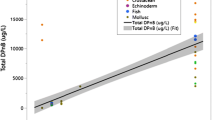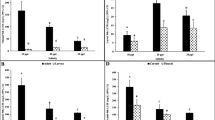Abstract
Chemical dispersants can be a useful tool to mitigate oil spills. This study examined potential risks to sensitive estuarine species by comparing the toxicity of two dispersants (Corexit® EC9500A and Finasol® OSR 52) individually and in chemically enhanced water-accommodated fractions (CEWAFs) of Louisiana Sweet Crude oil. Acute toxicity thresholds and sublethal biomarker responses were determined in seven species (sheepshead minnow, grass shrimp, mysid, amphipod, polychaete, hard clam, mud snail). Comparing median lethal (LC50) values for the dispersants, Finasol was generally more toxic than Corexit and had greater sublethal toxicity (impaired embryonic hatching, increased lipid peroxidation, decreased acetylcholinesterase activity). The nominal concentration-based mean LC50 for all species tested with Corexit was 150.31 mg/L compared with 43.27 mg/L with Finasol. Comparing the toxicity of the CEWAFs using the nominal concentrations (% CEWAF), Corexit-CEWAFs appeared more toxic than Finasol-CEWAFs; however, when LC50 values were calculated using measured hydrocarbon concentrations, the Finasol-CEWAFs were more toxic. There was greater dispersion efficiency leading to greater hydrocarbon concentrations measured in the Corexit-CEWAF solutions than in equivalent Finasol-CEWAF solutions. The measured concentration-based mean LC50 values for all species tested with Corexit-CEWAF were 261.96 mg/L total extractable hydrocarbons (TEH) and 2.95 mg/L total polycyclic aromatic hydrocarbons (PAH), whereas the mean LC50 values for all species tested with Finasol-CEWAF were 23.19 mg/L TEH and 0.49 mg/L total PAH. Larval life stages were generally more sensitive to dispersants and dispersed oil than adult life stages within a species. These results will help to inform management decisions regarding the use of oil-spill dispersants.
Similar content being viewed by others
References
Anderson JW, Neff JM, Cox BA, Tatem HE, Hightower GM (1974) Characteristics of dispersions and water-soluble extracts of crude and refined oils and their toxicity to estuarine crustaceans and fish. Mar Biol 27:75–88. doi:10.1007/BF00394763
Aurand D, Coelho G (2005) Cooperative aquatic toxicity testing of dispersed oil and the “Chemical Response to Oil Spills: Ecological Effects Research Forum (CROSERF)” A model for cooperative research by industry and government, Technical Report 07-03. Ecosystem Management & Associates, Inc., Lusby, MD
Bejarano AC, Clark JR, Coelho GM (2014) Issues and challenges with oil toxicity data and implications for their use in decision making: a quantitative review. Environ Toxicol Chem 33:732–742
Chandler GT, Cary TL, Volz DC, Walse SS, Ferry JL, Klosterhaus SL (2004) Fipronil effects on estuarine copepod (Amphiascus tenuiremis) development, fertility and reproduction: a rapid life-cycle assay in 96-well microplate format. Environ Toxicol Chem 23:117–124
Council NR (2005) Understanding oil spill dispersants: efficacy and effects. National Academies Press, Washington
DeLorenzo ME, De Leon RG (2010) Toxicity of the insecticide etofenprox to three life stages of the grass shrimp, Palaemonetes pugio. Arch Environ Contam Toxicol 58:985–990
DeLorenzo ME, Serrano L, Chung KW, Hoguet J, Key PB (2006) Effects of the insecticide permethrin on three life stages of the grass shrimp, Palaemonetes pugio. Ecotoxicol Environ Saf 64:122–127
DeLorenzo ME, Chung KW, Key P, Fulton MH (2012) Mixture toxicity of crude oil and Corexit 9500 to estuarine organisms. Int J Environ Sci Eng Res 3:161–169
Dussauze M et al (2014) Impact of dispersed fuel oil on cardiac mitochondrial function in polar cod Boreogadus saida. Environ Sci Pollut Res 21:13779–13788. doi:10.1007/s11356-014-2618-0
Fuller C, Bonner J, Page C, Ernest A, McDonald T, McDonald S (2004) Comparative toxicity of oil, dispersant, and oil plus dispersant to several marine species. Environ Toxicol Chem 23:2941–2949
Guilherminoa L, Lacerdaa MN, Nogueirab AJA, Soaresb AMVM (2000) In vitro and in vivo inhibition of Daphnia magna acetylcholinesterase by surfactant agents: possible implications for contamination biomonitoring. Sci Tot Environ 247:137–141
Hemmer MJ, Barron MG, Greene RM (2011) Comparative toxicity of eight oil dispersants, Louisiana Sweet Crude oil (LSC), and chemically dispersed LSC to two aquatic test species. Environ Toxicol Chem 30:2244–2252. doi:10.1002/etc.619
Kennedy SW, Jones SP (1994) Simultaneous measurement of cytochrome P4501A catalytic activity and total protein concentration with a fluorescence plate reader. Anal Biochem 222:217–222
Key PB, Fulton MH, Scott GI, Layman SL, Wirth EF (1998) Lethal and sublethal effects of malathion on three life stages of the grass shrimp, Palaemonetes pugio. Aquat Tox 40:311–322
Kujawinski EB, Kido Soule MC, Valentine DL, Boysen AK, Longnecker K, Redmond MC (2011) Fate of dispersants associated with the deepwater horizon oil spill. Environ Sci Technol 45:1298–1306
Lessard RR, Demarco G (2000) The significance of oil spill dispersants. Spill Sci Technol Bull 6:59–68
Martinez-Tabche L, Mora BR, Faz CG, Castelan IG, Ortiz MM, Gonzalez VU, Flores MO (1997) Toxic effect of sodium dodecylbenzenesulfonate, lead, petroleum, and their mixtures on the activity of acetylcholinesterase of Moina macrocopa in vitro. Environ Toxicol 12:211–215. doi:10.1002/(SICI)1098-2256(1997)12:3<211:AID-TOX2>3.0.CO;2-B
Parent LM, DeLorenzo ME, Fulton MH (2011) Effects of the synthetic pyrethroid insecticide, permethrin, on two estuarine fish species. J Environ Sci Health B 46:615–622
Ragland JM, Liebert D, Wirth E (2014) Using procedural blanks to generate analyte-specific limits of detection for persistent organic pollutants based on GC-MS analysis. Anal Chem 86:7696–7704. doi:10.1021/ac501615n
Ramachandran SD, Hodson PV, Khan CW, Lee K (2004) Oil dispersant increases PAH uptake by fish exposed to crude oil. Ecotoxicol Environ Saf 59:300–308. doi:10.1016/j.ecoenv.2003.08.018
Ringwood AH, Hoguet J, Keppler CJ, Gielazyn ML, Ward BP, Rourk AR (2003) Cellular biomarkers (lysosomal destabilization, glutathione & lipid peroxidation) in three common estuarine species: a methods handbook. South Carolina Department of Natural Resources Marine Resources Research Institute, Charleston
Rossi S, Anderson J (1976) Toxicity of water-soluble fractions of No. 2 fuel oil and South Louisiana crude oil to selected stages in the life history of the polychaete. Neanthes arenaceodentata. Bull Environ Contam Toxicol 16:18–24
Sammarco PW, Kolian SR, Warby RAF, Bouldin JL, Subra WA, Porter SA (2013) Distribution and concentrations of petroleum hydrocarbons associated with the BP/Deepwater Horizon Oil Spill, Gulf of Mexico. Mar Poll Bull 73:129–143. doi:10.1016/j.marpolbul.2013.05.029
Scarlett A, Galloway T, Canty M, Smith E, Nilsson J, Rowland SJ (2005) Comparative toxicity of two oil dispersants, Superdispersant-25 and Corexit 9527, to a range of coastal species. Environ Toxicol Chem 24:1219–1227
USEPA (2003) U.S. Environmental Protection Agency Finasol® OSR 52 Technical Product Bulletin #D-11 vol Original Listing Date: 30 January 2003
Wheeler MW, Park RM, Bailer AJ (2006) Comparing median lethal concentration values using confidence interval overlap or ratio tests. Environ Toxicol Chem 25:1441–1444
Wooten KJ, Finch BE, Smith PN (2011) Embryotoxicity of Corexit 9500 in mallard ducks (Anas platyrhynchos). Ecotoxicol 21:662–666
Zheng M, Ahuja M, Bhattacharya D, Clement TP, Hayworth JS, Dhanasekaran M (2014) Evaluation of differential cytotoxic effects of the oil spill dispersant Corexit 9500. Life Sci 95:108–117. doi:10.1016/j.lfs.2013.12.010
Acknowledgements
The authors thank Debbie Payton, Scott Lundgren, Alan Mearns, and Gary Shigenaka of NOAA/National Ocean Service/Office of Response and Restoration–Emergency Response Division for helpful suggestions and scientific exchange of ideas during the proposal and experimental planning phase of this project. The authors thank Adriana Bejarano for assistance in acquiring the Corexit and oil for testing. Finasol was purchased from Total Fluides, Paris-La Defense, France. The authors also thank the student researchers who participated in this project: McCall Calvert, Jeffrey Good, Elaina Graham, Casey Hughes, Megan Meek, Mildred Thomas, and Alfre Wimberley. The authors thank Jeanine Morey, Dalina Viveros, and Maggie Broadwater for reviewing the manuscript. The scientific results and conclusions, as well as any opinions expressed herein, are those of the author(s) and do not necessarily reflect the views of NOAA or the Department of Commerce. The mention of any commercial product is not meant as an endorsement by the Agency or Department.
Author information
Authors and Affiliations
Corresponding author
Electronic supplementary material
Below is the link to the electronic supplementary material.
Rights and permissions
About this article
Cite this article
DeLorenzo, M.E., Key, P.B., Chung, K.W. et al. Comparative Toxicity of Two Chemical Dispersants and Dispersed Oil in Estuarine Organisms. Arch Environ Contam Toxicol 74, 414–430 (2018). https://doi.org/10.1007/s00244-017-0430-9
Received:
Accepted:
Published:
Issue Date:
DOI: https://doi.org/10.1007/s00244-017-0430-9




